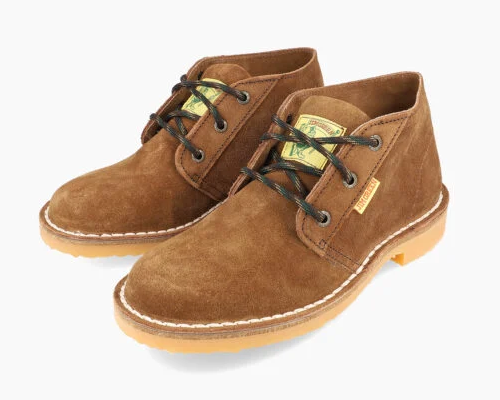There is no shortage of opinions and information when it comes to footwear. Here in the rural Pacific Northwest, I don't really care about any level of fashion above "business casual," but your mileage may vary. I rely heavily on the Rose Anvil YouTube channel for practical analysis of materials and craftsmanship. If fashion is more your concern, I also suggest The Art of Manliness for timeless information and modern advice with minimal hype.
Iron Rangers Update
In a previous post, I compared my new Red Wing Iron Rangers with surplus military boots and a cheap pair of "tactical" work boots. I remain quite pleased with the Iron Rangers. I have been wearing them almost daily since then, and I find they pair well (pun intended) with some Wigwam wool blend socks for a bit more insulation. More support for Midwestern manufacturing is just a bonus. I'm not an economic nationalist, but most of the remaining US-based manufacturers have withstood competition from cheap imports for good reason.
Here in the Pacific Northwest, we have local boot makers galore. Just in Spokane, White's Boots, Nick's Handmade Boots, and JK Boots all compete to offer the toughest handmade footwear in the region, and perhaps even the world, although Wesco in Oregon might dispute that point, and Viberg might offer some polite but firm Canadian arguments here and there, too. But after weighing my options, Red Wing just had the right balance of quality and cost for my specific needs.
All that being said, even my lighter-duty boots are sometimes overkill. I wanted a pair of shoes, too. As with boots, I am tired of cheap shoes made from flimsy synthetics, and the over-the-top styling of athletic shoes just doesn't work with my personal style (or lack thereof). I'm not a bleeding-heart environmentalist, but I detest waste in material and money alike. I'm no sneakerhead, and I don't feel old enough yet to settle into New Balance dad shoes for the rest of my life, either. So I experimented with an imported shoe in a very traditional style.
Jim Green
Jim Green originates from a well-known fly fishing area within the rolling hills of the Midlands Meander, KwaZulu-Natal, South Africa. Along the river edges in the area lives a sneaky little frog, known to locals as a “Jim Green”.
Jim Green is a South African company in the city of Pietermaritzburg. Their claim to fame is over three decades of manufacturing traditional vellies and boots in South Africa with an emphasis in sourcing their materials locally.
Importing shoes can be an expensive proposition with layers of taxes and fees. They now have US distribution, however.
My Vellies
Veldskoene ("FELT-skoona") or colloquially vellies ("FELL-ys") are South African walking shoes [...] They are sometimes considered light boots, and can essentially be considered a subset of chukka boots or desert boots although vellies tend to have a lower topline. (Wikipedia)
I bought the Rough Out Vellie in "chestnut." These feel much lighter on my feet than boots, and the sole feels a lot closer to sneaker rubber than the clompy stiff soles on my Red Wings. So far, I'm quite happy with them, but I have a few notes if you're interested as well.
They don't fit snugly around my ankles like sneakers. They aren't loose at the heel, but they don't quite give the same impression of security for running.
I had to drop a full size from my usual US shoe size. However, the toe box gives lots of room for my wider-than-average feet. That's what drew me to try these in the first place.
Like any leather footwear, there is some break-in required. These will need to be adjusted frequently at first while they conform to your feet, and the first couple days might have some discomfort.
The laces and removable insoles are likely to need upgrading. However, both are good enough for me for now, easy to swap out if I change my mind.
Stitchdown construction makes these easy to resole and repair, unlike most shoes today. The double row of stitches around the entire perimeter at least looks like the manufacturer went the extra mile for durability.
These are on sale for $99.00 (USD) as of this post, and look to offer far better construction quality than any mass-produced athletic shoes anywhere close to that price point, albeit with less athletic performance benefits. If you play sports or do any running, you might still want some "tenner shoes" instead.
Tenner Shoes
Not sure what I mean? I suggest a story entitled "Tenner Shoes" from They Shoot Canoes, Don’t They? by Patrick F. McManus. I found a couple videos of people reading it aloud on YouTube.
98¢ for tenners? If only...
Concluding Thoughts
All told, the Jim Green Vellies are just about perfect for the kind of shoe I want. They look boring enough for business casual, or even slightly less casual situations, without being a miserable stiff pointy-toe dress shoe. They have a much less boot-like feel under foot for daily wear. That's not to say I won't buy foam-and-plastic athletic shoes again at some point. They have a place. I just don't want to use them as an everyday option.
I don't know where Jim Green ranks in terms of South African shoe companies, but this pair I bought seems well-built. I might consider their boots in the future, especially if I need a steel toe cap. The African Ranger also seems to have a lot of positive hype online among boot enthusiasts. Of course, long-term durability remains to be seen, but Jim Green is definitely worth a look if you are in the market for more heritage-influenced footwear without quite as much of a price hurdle.


You take your shoes seriously!
I am ready to seriously address a long-term source of frustration.